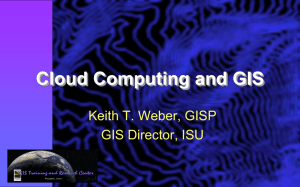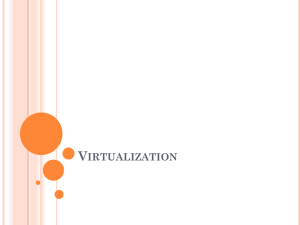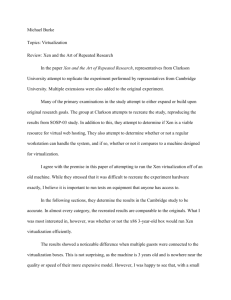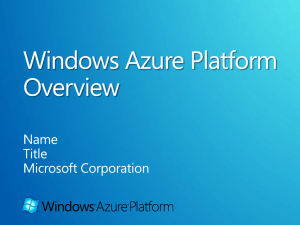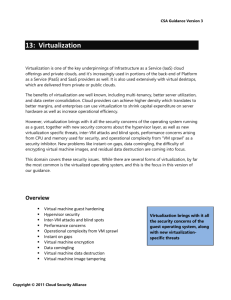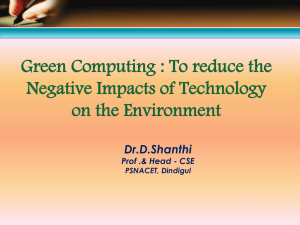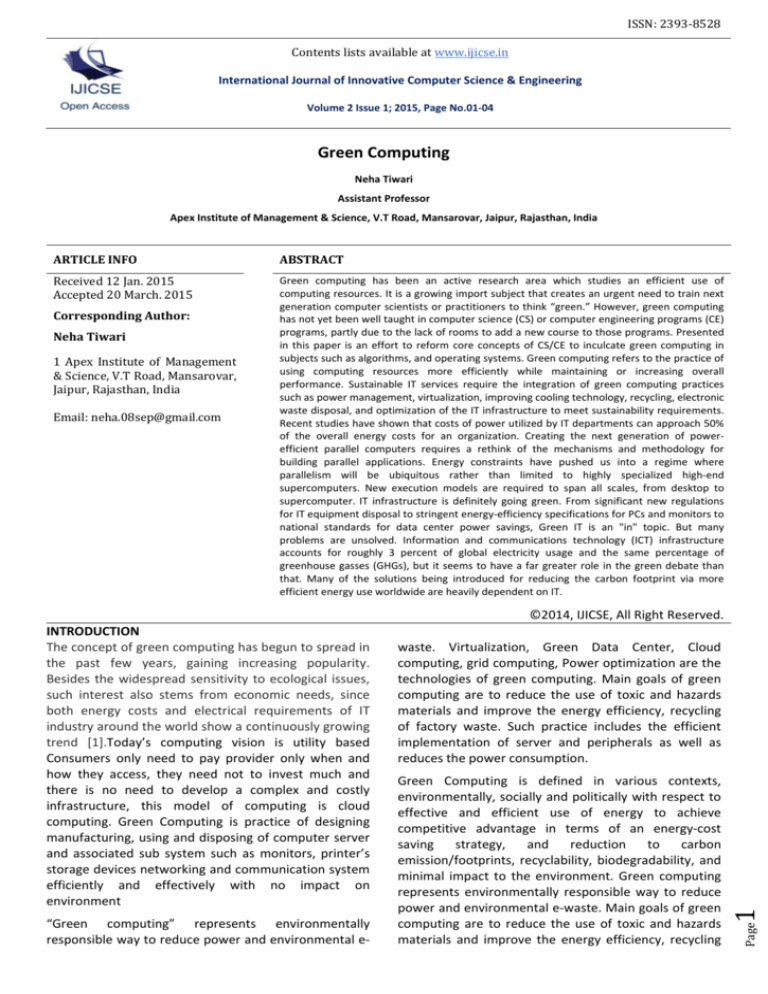
ISSN: 2393-8528
Contents lists available at www.ijicse.in
International Journal of Innovative Computer Science & Engineering
Volume 2 Issue 1; 2015, Page No.01-04
Green Computing
Neha Tiwari
Assistant Professor
Apex Institute of Management & Science, V.T Road, Mansarovar, Jaipur, Rajasthan, India
ARTICLE INFO
ABSTRACT
Received 12 Jan. 2015
Accepted 20 March. 2015
Green computing has been an active research area which studies an efficient use of
computing resources. It is a growing import subject that creates an urgent need to train next
generation computer scientists or practitioners to think “green.” However, green computing
has not yet been well taught in computer science (CS) or computer engineering programs (CE)
programs, partly due to the lack of rooms to add a new course to those programs. Presented
in this paper is an effort to reform core concepts of CS/CE to inculcate green computing in
subjects such as algorithms, and operating systems. Green computing refers to the practice of
using computing resources more efficiently while maintaining or increasing overall
performance. Sustainable IT services require the integration of green computing practices
such as power management, virtualization, improving cooling technology, recycling, electronic
waste disposal, and optimization of the IT infrastructure to meet sustainability requirements.
Recent studies have shown that costs of power utilized by IT departments can approach 50%
of the overall energy costs for an organization. Creating the next generation of powerefficient parallel computers requires a rethink of the mechanisms and methodology for
building parallel applications. Energy constraints have pushed us into a regime where
parallelism will be ubiquitous rather than limited to highly specialized high-end
supercomputers. New execution models are required to span all scales, from desktop to
supercomputer. IT infrastructure is definitely going green. From significant new regulations
for IT equipment disposal to stringent energy-efficiency specifications for PCs and monitors to
national standards for data center power savings, Green IT is an "in" topic. But many
problems are unsolved. Information and communications technology (ICT) infrastructure
accounts for roughly 3 percent of global electricity usage and the same percentage of
greenhouse gasses (GHGs), but it seems to have a far greater role in the green debate than
that. Many of the solutions being introduced for reducing the carbon footprint via more
efficient energy use worldwide are heavily dependent on IT.
1 Apex Institute of Management
& Science, V.T Road, Mansarovar,
Jaipur, Rajasthan, India
Email: neha.08sep@gmail.com
INTRODUCTION
The concept of green computing has begun to spread in
the past few years, gaining increasing popularity.
Besides the widespread sensitivity to ecological issues,
such interest also stems from economic needs, since
both energy costs and electrical requirements of IT
industry around the world show a continuously growing
trend [1].Today’s computing vision is utility based
Consumers only need to pay provider only when and
how they access, they need not to invest much and
there is no need to develop a complex and costly
infrastructure, this model of computing is cloud
computing. Green Computing is practice of designing
manufacturing, using and disposing of computer server
and associated sub system such as monitors, printer’s
storage devices networking and communication system
efficiently and effectively with no impact on
environment
“Green computing” represents environmentally
responsible way to reduce power and environmental e-
©2014, IJICSE, All Right Reserved.
waste. Virtualization, Green Data Center, Cloud
computing, grid computing, Power optimization are the
technologies of green computing. Main goals of green
computing are to reduce the use of toxic and hazards
materials and improve the energy efficiency, recycling
of factory waste. Such practice includes the efficient
implementation of server and peripherals as well as
reduces the power consumption.
Green Computing is defined in various contexts,
environmentally, socially and politically with respect to
effective and efficient use of energy to achieve
competitive advantage in terms of an energy-cost
saving
strategy,
and
reduction
to
carbon
emission/footprints, recyclability, biodegradability, and
minimal impact to the environment. Green computing
represents environmentally responsible way to reduce
power and environmental e-waste. Main goals of green
computing are to reduce the use of toxic and hazards
materials and improve the energy efficiency, recycling
1
Neha Tiwari
Page
Corresponding Author:
Neha Tiwari/ Green Computing
of factory waste. Such practice includes the efficient
implementation of server and peripherals as well as
reduces the power consumption.[2]
Advantages of Green Computing
1. Reduced energy usage from green computing
techniques translates into lower carbon dioxide
emissions, stemming from a reduction in the fossil fuel
used in power plants and transportation.
2. Conserving resources means less energy is required
to produce, use, and dispose of products.
3. Saving energy and resources saves money.
4. Green computing even includes changing
government policy to encourage recycling and lowering
energy use by individuals and businesses.
5. Reduce the risk existing in the laptops such as
chemical known to cause cancer, nerve damage and
immune reactions in humans [3]
Approaches for green computing
Study shows that most of data centers don’t have
sufficient cooling capacity this is the cause of
environmental pollution. Green computing is deals with
concepts reduce energy consumption, recycling
eliminate hazardous elements but it also deals with
reduce in the business travel sharing the resources
(cloud computing) and optimization. There are a lot of
fundamental steps that can be taken to significantly
decrease the power consumption and impact on
environment.
Lower Power hardware: computer systems are made
up of hardware i.e. processor onboard graphics, disk,
fan etc these hardware should be consumed less
power.
Wireless Network Sensor:
Sensor employed in
different parts area in a data center to determine the
temperature of each area, this will tell which area need
to be more cool and where to reduce cooling.
Recycle: Through recycling the waste or equipment we
can reduce the environmental pollution [4
Figure 1: Virtualization Environment
Virtualization is the abstraction of an OS and
applications running on it from the hardware. Physical
resources can be split into a number of logical slices
called
Virtual
Machines(VMs).Each
VM
can
accommodate an individual OS creating for the user a
view of a dedicated physical resource and ensuring
performance and failure isolation between VMs sharing
a single physical machine. The virtualization layer lies
between the hardware and OS and; therefore, a Virtual
Machine Monitor (VMM) tacks control over resources
and has to be involved in the system’s power
management in order to provide efficient operation.
Figure 2: Virtualized Layer
Page
2
Virtualization: It is the use of software to simulate
hardware. In the data center stand alone server system
replaced with virtual server that run as software on a
small number of larger computer via a virtualized server
we can efficiently use computer resources.
Cloud computing: It has many benefits it enables
anybody to obtain environmental benefits of
virtualization It also remove the need for the user to
run high power PCs since it provide infrastructure as a
service.
Neha Tiwari/ Green Computing
Server Virtualization
(i) Server virtualization offers a way to consolidate
servers by allowing you to run multiple different
workloads on one physical host server. A "virtual
server" is a software implementation that executes
programs like a real server. Multiple virtual servers can
work simultaneously on one physical host server.
Therefore, instead of operating many servers at low
utilization, virtualization combines the processing
power onto fewer servers that operate at higher total
utilization.
(ii) Virtualization
improves
scalability,
reduces
downtime, and enables faster deployments. In addition,
it speeds up disaster recovery efforts because virtual
servers can restart applications much more rapidly than
physical servers. With virtualization, you can move
entire systems from one physical server to another in
(v)
just a few seconds to optimize workloads or to perform
maintenance without causing downtime. Some
virtualization solutions also have built-in resiliency
features, such as high availability, load balancing and
failover capabilities.
(iii) Due to these benefits, virtualization has become
commonplace in large data centers. A 2011 survey of
over 500 large enterprise data centers found that 92%
use virtualization to some degree.5Of those, the ratio of
virtual servers to physical host server averaged 6.3 to 1
and 39% of all servers were virtual.
(iv) However, virtualization is less common in small
data centers. A 2012 NRDC paper entitled Small Server
Rooms, Big Energy Savings6 included an informal survey
of 30 small businesses (ranging from 3 to 750
employees) and found that only 37% used
virtualization.
Figure 3: Server virtualization in Data Centers
while the software and user’s data is stored on remote
data server. As well as Cloud computing allows
companies to avoid infrastructure cost, and focus on
projects that differentiate their business. Cloud
computing allows enterprises to get their application up
running faster with improved man power and less
maintenance and enable IT to more rapidly adjust
resources to meet the unpredictable business demand.
Figure 4: Cloud Computing
Page
3
Cloud Computing:
Cloud computing name comes from the cloud shaped
symbol in which the complex infrastructure is hidden as
it contain in its system diagram. Cloud computing
delivered the computing resources as a service over the
internet. Cloud computing provide user’s data, software
remotely End user can use the cloud services or cloud
application through a web browser or a mobile app
Neha Tiwari/ Green Computing
REFERENCES:
4
1. Green
Computing
and
Communications
(GreenCom),
2011
IEEE/ACM
International
Conference.
2. A Study about Green Computing” Pushtikant
Malviya, Shailendra Singh, International Journal of
Advanced Research in Computer Science and
Software Engineering, Volume 3, Issue 6, June 2013.
3. Sonu Choudhary / (IJCSIT) International Journal of
Computer Science and Information Technologies,
Vol. 5 (5) , 2014, 6248-6252
4. Malviya et al., International Journal of Advanced
Research in Computer Science and Software
Engineering 3(6), June - 2013, pp. 790-794
5. Malviya et al., International Journal of Advanced
Research in Computer Science and Software
Engineering 3(6), June - 2013, pp. 790-794
6. Maulik R. Kamdar Department of Biotechnology,
Indian Institute of Technology, Kharagpur Whilst
submitting research documentation for the ITC
‘Networking for Green Earth’ Competition
Page
CONCLUSION:
Green computing, the study and practice of efficient
and eco-friendly computing resources, is now under the
attention of not only environmental organizations, but
also businesses from other industries. In recent years,
companies in the computer industry have come to
realize that going green is in their best interest, both in
terms of public relations and reduced costs.[5]There is a
compelling need for applications to take environmental
factors into account in their design, driven by the need
to align with organizational environmental policies,
reduce power and infrastructure costs and to reduce
current or future carbon costs. The potential reduction
in energy and emissions footprint through good
architectural design is significant. The move to more
environmentally sustainable applications impacts
software and infrastructure architecture. Use of toxic
materials like lead can be replaced by silver and copper
making recycling of computers (which is expensive and
time consuming at present) more effective by recycling
computer parts separately with a option of reuse or
resale.[6]


